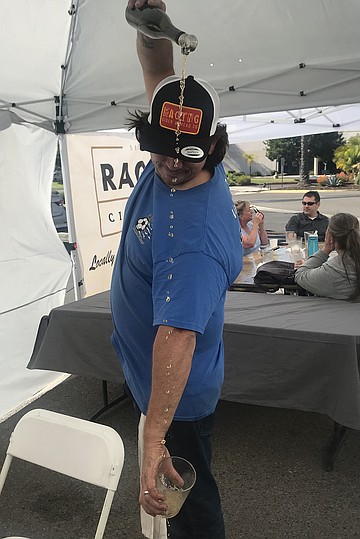 Facebook
Facebook
 X
X
 Instagram
Instagram
 TikTok
TikTok
 Youtube
Youtube

“They’re pouring!” says my friend Kim. We all stand up — some to get out of the splash zone, some to see just how people have been doing this for hundreds of years. We’re in San Marcos, at a little outlet not far from where they process local apples into cider, and also honey from local beehives into mead, maybe the most ancient alcoholic drink of all.
Dave Carr, who grows most of the apples that become the cider, has what looks like a magnum of champagne and — ulp — he’s turning it upside-down above his head. A golden gurgle comes out of the bottle mouth, drollop by gloopy drollop. But Dave is staring down, not up, his gaze fixed on a pint glass he’s holding in his other hand. And miraculously, each drollop whizzes down beside his chest and slides cleanly into the glass.“Cider needs to be aerated,” he shouts above the claps of everybody. “This is how they’ve done it for hundreds of years. You’re not a man if you don’t know how to pour a cider! This is how the Spanish do it in Asturias.”

We’re up here in San Marcos for a sidra (cider) celebration. Already the cider is pouring, and Dave’s colleagues bring tapas snacks out to help the 20-30 of us in attendance to keep drinking the different samples. Dave and his colleagues have apple orchards nearby, and every harvest season, they turn those apples into cider. This afternoon, it’s our pleasant duty to opine on the results.
Actually, the first couple of cider pours are a bit rough. “That’s because they are the most recent,” says Dave. “Each pour, we’re going back in time. It will get smoother.”
Dave, who’s from the UK, says the cider is stronger here in California. “We have more sun and less rain. In England it might be 5-6 percent alcohol. Here, it’s about 9 percent. It’s also gluten-free and naturally fermented, which happens only because of our wild yeasts.”
“And remember,” says Kim. “We’re doing this for patriotic reasons. John Adams drank a pint of cider every morning. Should we do any less?”
“Right!” says Dave. “Ladies and gentlemen, you have seen how the pour is done in Asturias, in northern Spain. Now the rest is up to you.”
There’s a general groan, but each of us has to take the bottle and a glass and try to pour from on high. It makes for a wet and hilarious afternoon, especially after downing a couple of our own efforts.
Dave says he’s trying to persuade local apple orchard owners to sell him more of their apples for pressing. “We are making good sidra now. If people will take their orchards seriously, San Diego County could become a respected cider region. It’s healthy, like gluten-free wine. Salud!”


“They’re pouring!” says my friend Kim. We all stand up — some to get out of the splash zone, some to see just how people have been doing this for hundreds of years. We’re in San Marcos, at a little outlet not far from where they process local apples into cider, and also honey from local beehives into mead, maybe the most ancient alcoholic drink of all.
Dave Carr, who grows most of the apples that become the cider, has what looks like a magnum of champagne and — ulp — he’s turning it upside-down above his head. A golden gurgle comes out of the bottle mouth, drollop by gloopy drollop. But Dave is staring down, not up, his gaze fixed on a pint glass he’s holding in his other hand. And miraculously, each drollop whizzes down beside his chest and slides cleanly into the glass.“Cider needs to be aerated,” he shouts above the claps of everybody. “This is how they’ve done it for hundreds of years. You’re not a man if you don’t know how to pour a cider! This is how the Spanish do it in Asturias.”

We’re up here in San Marcos for a sidra (cider) celebration. Already the cider is pouring, and Dave’s colleagues bring tapas snacks out to help the 20-30 of us in attendance to keep drinking the different samples. Dave and his colleagues have apple orchards nearby, and every harvest season, they turn those apples into cider. This afternoon, it’s our pleasant duty to opine on the results.
Actually, the first couple of cider pours are a bit rough. “That’s because they are the most recent,” says Dave. “Each pour, we’re going back in time. It will get smoother.”
Dave, who’s from the UK, says the cider is stronger here in California. “We have more sun and less rain. In England it might be 5-6 percent alcohol. Here, it’s about 9 percent. It’s also gluten-free and naturally fermented, which happens only because of our wild yeasts.”
“And remember,” says Kim. “We’re doing this for patriotic reasons. John Adams drank a pint of cider every morning. Should we do any less?”
“Right!” says Dave. “Ladies and gentlemen, you have seen how the pour is done in Asturias, in northern Spain. Now the rest is up to you.”
There’s a general groan, but each of us has to take the bottle and a glass and try to pour from on high. It makes for a wet and hilarious afternoon, especially after downing a couple of our own efforts.
Dave says he’s trying to persuade local apple orchard owners to sell him more of their apples for pressing. “We are making good sidra now. If people will take their orchards seriously, San Diego County could become a respected cider region. It’s healthy, like gluten-free wine. Salud!”
Comments